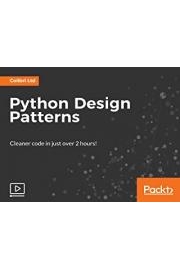Python Design Patterns is a highly informative and engaging show that delves into the world of software design patterns using the Python programming language. In its first season, this educational series has captivated viewers with its well-structured episodes, providing a detailed exploration of various design patterns and their implementation in Python.
On this particular episode, titled "Chain of Responsibility," the hosts take us on a journey to unravel a powerful behavioral design pattern widely used in object-oriented programming. The episode demonstrates how the Chain of Responsibility pattern can effectively decouple senders and receivers of requests, allowing them to communicate without directly knowing each other's identity.
The episode begins with a brief overview of the motivations behind the Chain of Responsibility pattern. By establishing a chain of potential handlers, this pattern enables a sender to pass a request along this chain until it is handled by an appropriate receiver. This greatly enhances flexibility and scalability in software systems, as different handlers can be added or removed dynamically.
As the hosts dive deeper into the subject, they present real-life examples where the Chain of Responsibility pattern can be applied. From handling user input validation to processing customer support requests, this pattern proves to be an invaluable tool for building robust and extensible software solutions. Through code examples and detailed explanations, the hosts illustrate how the chain is constructed and how requests are passed along until they find their proper handler.
To provide a comprehensive understanding of the topic, the episode explores different variations of the Chain of Responsibility pattern. The hosts discuss the concept of an abstract handler and multiple concrete handlers, highlighting the importance of properly setting up the chain's order. They emphasize the flexibility of this pattern, which allows for variations like pass-through handlers, handlers with both pre and post-processing capabilities, and more.
Throughout the episode, the hosts ensure that viewers fully grasp the advantages and trade-offs of implementing the Chain of Responsibility pattern. They shed light on the potential pitfalls and common mistakes that developers might encounter while designing a chain, emphasizing the importance of maintaining a well-defined and robust structure.
In addition to the theoretical aspects of the Chain of Responsibility pattern, the hosts also provide practical insights on its implementation in Python. They demonstrate the steps required to design and implement a chain using this powerful programming language. The code examples are comprehensive, enabling viewers to follow along and grasp the core concepts effortlessly.
As with every episode of Python Design Patterns, the hosts thoroughly address any questions or concerns that viewers might have. They provide clear explanations, real-world use cases, and best practices to ensure that the audience gains a solid understanding of the Chain of Responsibility pattern and its practical implications.
Overall, "Chain of Responsibility" from season 1 of Python Design Patterns offers a fascinating exploration of one of the most essential design patterns in modern software development. With its engaging format, the episode provides viewers with valuable insights, practical examples, and a deep understanding of how to effectively implement the Chain of Responsibility pattern in their Python projects. Whether you're a seasoned developer or a newcomer to software design patterns, this episode is certain to enrich your knowledge and expand your programming skills. Don't miss out on this exciting journey into the world of Python and design patterns!
-
Channel
-
First AiredSeptember 27, 2017
-
Runtime5 min
-
LanguageEnglish

-
 MyFreeDIRECTV is a new free premium TV experience.
MyFreeDIRECTV is a new free premium TV experience.
-
 Enjoy a curated selection of popular free live channels and On Demand library.
Enjoy a curated selection of popular free live channels and On Demand library.
-
 Try the DIRECTV experience - All you need is the DIRECTV app.
Try the DIRECTV experience - All you need is the DIRECTV app.

 MyFreeDIRECTV is a new free premium TV experience.
MyFreeDIRECTV is a new free premium TV experience.
 Enjoy a curated selection of popular free live channels and On Demand library.
Enjoy a curated selection of popular free live channels and On Demand library.
 Try the DIRECTV experience - All you need is the DIRECTV app.
Try the DIRECTV experience - All you need is the DIRECTV app.